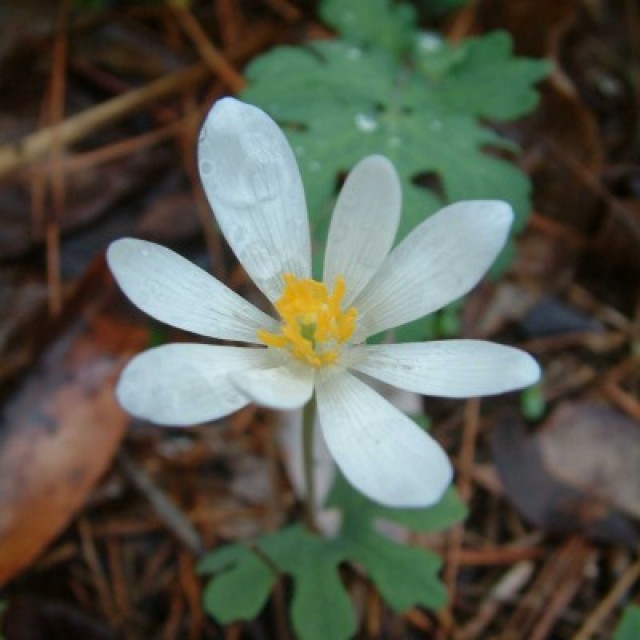COMMON NAME
Bloodroot
SCIENTIFIC NAME
Sanguinaria canadensis
ALSO KNOWN AS
Bloodwort, Pauson, Red puccoon root, Tetterwort
Plant family
Poppy (Papaveraceae)
Plant group
Wildflowers and Herbs
A 6 to 10 in tall woodland wildflower native to the eastern US. Emerges in early spring with one large palmate leaf. Flowers are white with 8-10 petaled with yellow stamens.
1125 reports
131+
OBSERVERS
1125+
OBSERVATIONS
Identification hints
Bloodroot is a 6-10" tall woodland wildflower native to the eastern United States. The plant emerges in early spring with one large palmate leaf wrapped around the flower bud. The leaf unfurls as the flower blooms or shortly thereafter. Flowers are white with 8-10 petals and bright yellow stamens and generally bloom between March and May. Leaves are green and horseshoe-shaped with several lobes. Leaf veins are prominent and give the leaf a quilted look. Fruits are long green pods that produces round seeds. Seeds turn black to orangish-red when ripe.
Did you know?
Bloodroot is mainly active in the spring, blooming and fruiting by early summer. Come mid- to late-summer, bloodroot plants become dormant. The flowers are pollinated by small insects such as bees and flies. The seeds are dispersed by ants. Bloodroot plants grow in wet to moist woods often near streams or wetland areas. All parts of this plant exude a red sap that native Americans used as a dye. The sap is toxic to animals and humans and has components which are being studied for possible cancer treatments. Bloodroot is cultivated as an ornamental and makes a beautiful spring flower in gardens.
DISTRIBUTION IN TH U.S.
Alabama
,
Arkansas
,
Connecticut
,
Delaware
,
Florida
,
Georgia
,
Iowa
,
Illinois
,
Indiana
,
Kansas
,
Kentucky
,
Louisiana
,
Massachusetts
,
Maryland
,
Maine
,
Michigan
,
Minnesota
,
Missouri
,
Mississippi
,
North Carolina
,
North Dakota
,
Nebraska
,
New Hampshire
,
New Jersey
,
New York
,
Ohio
,
Oklahoma
,
Pennsylvania
,
Rhode Island
,
South Carolina
,
South Dakota
,
Tennessee
,
Texas
,
Virginia
,
Vermont
,
Wisconsin
,
West Virginia
HABITAT
There is no information available about this species.
See Menu
- 2021 Chicago Botanic Garden. All Rights Reserved.
-
Creative Commons
BY-NC-SA 4.0 - Terms of Use
- Privacy Policy
- Data Sharing and Citation Policies
- 2021 Chicago Botanic Garden. All Rights Reserved.



